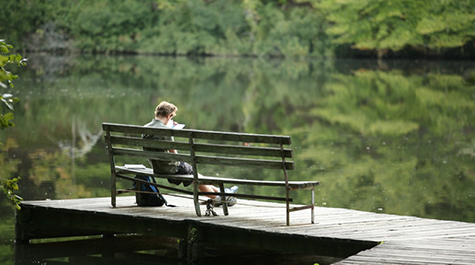W&M's Parks Research Lab releases Campus Greenspace Map
For the past seven years, Dorothy Ibes has been using William & Mary’s outdoor space as a laboratory to understand the relationship between human health and human access to nature.
“When I started at William & Mary in 2013, I never could have predicted that my research would become super relevant because of a pandemic,” said Ibes, senior lecturer in W&M’s Environmental Science and Policy Program and its Center for Geospatial Analysis (CGA).
As the university has had to de-densify campus in the wake of COVID-19, outdoor spaces such as the Sunken Garden and Martha Wren Briggs Amphitheatre are being adapted to serve as instructional space and areas for student activities.
Ibes has been studying and advocating for communities to increase the use of outdoor space for over a decade. She runs the university’s Parks Research Lab, which was formed with the mission to “increase understanding of the contribution of nature engagement to health, well-being and human flourishing through 'nearby nature' research and initiatives, while facilitating nature connection on campus and in our community.”
A team from the Parks Research Lab, in collaboration with the CGA, recently released a beta version of the William & Mary Campus Greenspace Map, which is available online and through W&M mobile app’s Healthy Together module.
Six years in the making, the map highlights all the publicly-accessible greenspaces, trails, patios and other outdoor spaces on and near the William & Mary campus and organizes them by activity, so users can select a space based on their own needs and preference.
“Every year, it's grown,” Ibes said. “Each new set of lab students adds more spaces to the map. I've been studying this campus for many years. I feel like I know it really well, but every year my students surprise me.”
The project was supported by a grant from the Commonwealth Center for Energy and the Environment and featured an interdisciplinary team of faculty advisors, including Chancellor Professor of Biology Dan Cristol and Sharon Zuber, professor emeritus in the university’s English department. Other contributors include Parks Research Lab student research assistants: Olivia Staub '20, Luke Hart-Moynihan '15, Katie Johanson '16, and Amelia Lowe '21; and Tyler Davis, Jordan Moghanaki, and Ella Kasten from the CGA.
“I remember the first iteration of the map was very rudimentary,” said Staub, who graduated in May and is preparing to start a job at IBM. “It was aesthetically beautiful, very artistically creative, but it wasn’t especially helpful. It had none of the layers it has now.”
Staub explained that the map was overhauled to inventory outdoor space based on use, rather than just location.
“Now you can filter it for all the different activities that you might want to do,” Staub said. “With indoor activities so limited right now, that feature is really helpful.”
For instance, if you want to see Brown-headed Cowbird, the map will point you in the right direction. Cristol and members of the W&M Bird Club used the map to mark locations where various species of birds have been spotted. Want to see a Japanese Temple Tree? Staub helped design a tree tour that functions as part of the map. Other spaces are marked for activities such as hiking, bicycling, studying, eating, relaxing and exploring.
“The process actually starts before you open the map,” Ibes said. “The first step is to check in with yourself and say, ‘what do I need right now?’ The map then helps you find a space outside to fulfill that need.”
In a recent study, Ibes and W&M’s Director of Neuroscience and Associate Professor of Psychological Sciences Catherine Forestell found that just 20 minutes spent outdoors offered students the same mental health benefits as 20 minutes of focused meditation.
“Just being outside, literally doing whatever you’d be doing inside, offered the same mood boost as a concentrated mindfulness activity,” Ibes said.
Even student participants who completed the neutral task of filling out a time diary, displayed a significant boost in mood by simply doing it outdoors. Even taking somewhat extreme cold and hot weather into account, the students still reported elevated moods, despite possible discomfort, Ibes explained.
“For years, I’ve been focused on the importance of outdoors for social, ecological and mental health, but now people have to use these spaces to safeguard against a virus,” Ibes said. “It’s not how we wanted this to happen, but it’s going to be so good for mental health. We need to be outside, just like we need water, food, air, sleep, companionship and affection. Human beings emerged and evolved in direct connection with nature. We need it.”
 Skip to main content
Skip to main content

